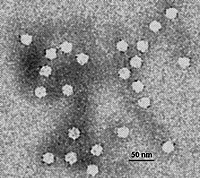
Photo from wikipedia
Feline panleukopenia virus (FPV) and canine parvovirus 2 (CPV-2) belong to the species Carnivore protoparvovirus 1. While FPV has been endemic in cats for many years, CPV-2 emerged at the… Click to show full abstract
Feline panleukopenia virus (FPV) and canine parvovirus 2 (CPV-2) belong to the species Carnivore protoparvovirus 1. While FPV has been endemic in cats for many years, CPV-2 emerged at the end of the 1970s and 3 antigenic variants (CPV-2a, b and c) are currently circulating in domestic and wild animals. Although raccoons played a fundamental role in the emergence of CPV-2a in dogs, knowledge about protoparvoviruses in these animals is still limited. We investigated 72 raccoons found dead or injured in southern British Columbia (BC), Canada, between 2009 and 2017. Among the 49 protoparvovirus-positive (66%) animals, 39 (80%) exhibited enteritis. Approximately 21% were FPV-positive and these were from Vancouver Island, while 79% were CPV-positive and found on the BC mainland, suggesting geographic separation of strains. Notably, one CPV-positive individual was FPV-vaccinated. The co-circulation of multiple FPV strains was observed, while the CPV-2 strain were all classified as CPV-2a, located in one unique clade, and likely originated from a single introduction. All BC CPV-2 sequences possessed a VP2-305His and therefore could represent one of the intermediate viruses that facilitated the emergence of CPV-2a in dogs. Like other raccoon viruses, all BC CPV-2 sequences possessed a VP2-300Asp but, differently, possessed a VP2-301Ala. Finally, two unique amino acid substitutions were identified in the NS1 of FPV (His554Gln and Gly573Cys). To our knowledge, this is the first molecular characterization of protoparvoviruses in wildlife from this region of North America and more studies are needed to elucidate the distribution of these viruses in wildlife outside the USA.
Journal Title: Virus research
Year Published: 2017
Link to full text (if available)
Share on Social Media: Sign Up to like & get
recommendations!